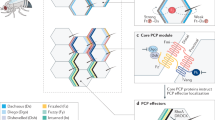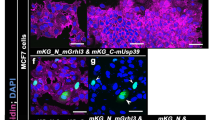Abstract
In epithelial cells, the tight junction divides the plasma membrane into distinct apical and basolateral domains. Polarization is essential for epithelial cell function, and apico-basal cell polarity is lost during the epithelial to mesenchymal transition (EMT), a program of events characterized not only by loss of cell polarity, but also by enhanced cell motility and increased cell invasion. Among several apically localized protein complexes, the Crumbs and Par protein complexes have pivotal roles in control of epithelial polarity and apical membrane formation. Here, we demonstrate that the Snail transcriptional repressor antagonizes expression of the Crumbs polarity complex. We show that Snail abolishes localization of the Crumbs and Par complexes to the tight junction, decreases Crumbs complex protein levels and suppresses Crumbs3 transcription. Evidence that Snail acts directly to antagonize Crumbs3 promoter activity is presented. Strikingly, we note that reexpression of exogenous Crumbs3 in Snail-expressing Madin–Darby Canine Kidney cells partially restores cell–cell junctions. Moreover, we find that the EMT inducer transforming growth factor-β elicits transcriptional repression of Crumbs3 and results in a measurable loss of Crumbs3 protein. Our findings provide new insights into the links between the transcriptional repression function of Snail and its role in antagonizing key apico-basal polarity factors during EMT.
This is a preview of subscription content, access via your institution
Access options
Subscribe to this journal
Receive 50 print issues and online access
$259.00 per year
only $5.18 per issue
Buy this article
- Purchase on Springer Link
- Instant access to full article PDF
Prices may be subject to local taxes which are calculated during checkout




Similar content being viewed by others
References
Aigner K, Dampier B, Descovich L, Mikula M, Sultan A, Schreiber M et al. (2007). The transcription factor ZEB1 (deltaEF1) promotes tumour cell dedifferentiation by repressing master regulators of epithelial polarity. Oncogene 26: 6979–6988.
Batlle E, Sancho E, Franci C, Dominguez D, Monfar M, Baulida J et al. (2000). The transcription factor snail is a repressor of E-cadherin gene expression in epithelial tumour cells. Nat Cell Biol 2: 84–89.
Cano A, Perez-Moreno MA, Rodrigo I, Locascio A, Blanco MJ, Del Barrio MG et al. (2000). The transcription factor snail controls epithelial-mesenchymal transitions by repressing E-cadherin expression. Nat Cell Biol 2: 76–83.
Hajra KM, Chen DY, Fearon ER . (2002). The SLUG zinc-finger protein represses E-cadherin in breast cancer. Cancer Res 62: 1613–1618.
Nieto MA . (2002). The snail superfamily of zinc-finger transcription factors. Nat Rev Mol Cell Biol 3: 155–166.
Ohkubo T, Ozawa M . (2004). The transcription factor Snail downregulates the tight junction components independently of E-cadherin downregulation. J Cell Sci 117: 1675–1685.
Peinado H, Olmeda D, Cano A . (2007). Snail, Zeb and bHLH factors in tumour progression: an alliance against the epithelial phenotype? Nat Rev Cancer 7: 415–428.
Roh MH, Makarova O, Liu CJ, Shin K, Lee S, Laurinec S et al. (2002). The Maguk protein, Pals1, functions as an adapter, linking mammalian homologues of Crumbs and discs lost. J Cell Biol 157: 161–172.
Shin K, Fogg VC, Margolis B . (2006). Tight junctions and cell polarity. Annu Rev Cell Dev Biol 22: 207–235.
Straight SW, Pieczynski JN, Whiteman EL, Liu CJ, Margolis B . (2006). Mammalian lin-7 stabilizes polarity protein complexes. J Biol Chem 281: 37738–37747.
Thiery JP, Sleeman JP . (2006). Complex networks orchestrate epithelial–mesenchymal transitions. Nat Rev Mol Cell Biol 7: 131–142.
Whiteman EL, Chen JJ, Birnbaum MJ . (2003). Platelet-derived growth factor (PDGF) stimulates glucose transport in 3T3-L1 adipocytes overexpressing PDGF receptor by a pathway independent of insulin receptor substrates. Endocrinology 144: 3811–3820.
Acknowledgements
This work was supported by NIH Grants DK058208 and DK069605 (to BM). ELW was supported by the Cancer Biology Training Program at the University of Michigan and an individual National Research Service Award (NIH Grants 5-T32-CA09676 and 5-F32-GM079906). This work utilized the Morphology and Image Analysis Core of the Michigan Diabetes Research and Training Center funded by NIH Grant 5-P60-DK20572. We thank Ron Koenig, Sanj Patel, Stephen Lentz, Toby Hurd, Shuling Fan, Jennifer Harder, Jay Pieczynski, Qian Wang and Kunyoo Shin for technical advice, reagents and critical discussions concerning this article.
Author information
Authors and Affiliations
Corresponding author
Additional information
Supplementary Information accompanies the paper on the Oncogene website (http://www.nature.com/onc)
Rights and permissions
About this article
Cite this article
Whiteman, E., Liu, CJ., Fearon, E. et al. The transcription factor snail represses Crumbs3 expression and disrupts apico-basal polarity complexes. Oncogene 27, 3875–3879 (2008). https://doi.org/10.1038/onc.2008.9
Received:
Revised:
Accepted:
Published:
Issue Date:
DOI: https://doi.org/10.1038/onc.2008.9
Keywords
This article is cited by
-
Helicobacter pylori and Epstein-Barr virus infection in cell polarity alterations
Folia Microbiologica (2024)
-
Pals1 functions in redundancy with SMAP1 to inhibit Arf6 in order to prevent Rac1-dependent colorectal cancer cell migration and invasion
Cancer Gene Therapy (2022)
-
Pals1 prevents Rac1-dependent colorectal cancer cell metastasis by inhibiting Arf6
Molecular Cancer (2021)
-
Trehalose ameliorates peritoneal fibrosis by promoting Snail degradation and inhibiting mesothelial-to-mesenchymal transition in mesothelial cells
Scientific Reports (2020)
-
Apical–basal polarity inhibits epithelial–mesenchymal transition and tumour metastasis by PAR-complex-mediated SNAI1 degradation
Nature Cell Biology (2019)



